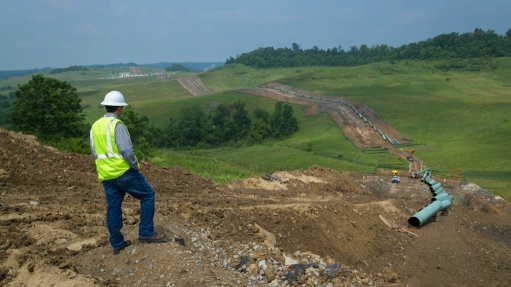Embracing technology key to success of the mine of the future


FUTURE MINE The trends around key mining industry issues could lead to possible futures characterised by an African mining boom
Photo by Bloomberg
For mining to be part of the twenty-first century, it has to create a range of benefits as part of the business model, have access to realistic commodity pricing models and must embrace technology, says University of the Witwatersrand (Wits) Mining Institute director Professor Fred Cawood.
In his keynote address at the South Africa-based mining software integrator MineRP Open Day in Sandton, Gauteng, in May, Cawood added that the mine of the future would be built and not found, be and look different, be funded and managed differently and require a different skill set.
The MineRP Open Day, hosted at multinational technology and consulting corporation IBM, centred around the latest developments regarding digitisation in the mining industry. MineRP, software giant SAP, IBM, Swedish engineering group Sandvik, Wits Mining School and University of Pretoria Mining School hosted the event for customers and clients in the mining industry.
The day formed part of MineRP’s ‘mining world tour’, which started in South America in April, and ended in Australia this month.
Cawood cited several significant mining issues in 2016, including weak commodity prices, which created the trend for growing scrutiny of mining company profits, where the global push for the technology-intensive mine of the future was intensifying.
The trends around key mining industry issues could lead to possible futures characterised by an African mining boom, persistent African poverty, sustainable mining, markets prepared to pay commodity prices that could accommodate all costs, State participation in mining becoming the rule rather than the exception, technology-intensive mines, as well as a need and use of a twenty-first century skill sets for mining, Cawood said.
“If these trends lead to the future we want, we . . . need to take advantage of what this future will offer, and if it is not the future we want, we need to change and build beacons for the mining industry,” he stressed.
Cawood pointed out that actions would be required in looking for opportunities in an African mining boom, if State participation was to become the norm and if mining companies were to deliver benefits.
Moreover, innovations would be required to tackle persistent African poverty and to ensure markets were prepared to pay prices that could pay for all, until now, externalised costs. Innovation was also required for a twenty-first-century skill set for technology-intensive mines, as well as to ensure sustainable mining, he added.
“A mine must be sustainable first, before it can execute sustainable development. One cannot have sustainable development without a sustainable mine,” Cawood emphasised.
Further, mining opportunities would centre on “crafting institutional arrangements from the mandates of stakeholders to agree on benefits and rent sharing, identifying current resources with the potential to be converted into reserves, identifying strategies to remove barriers to entry for mining and manufacturing, creating decent work to be performed by skilled employees, ensuring accelerated transformation of mining and society, as well as communicating mining benefits,” he said.
Cawood stressed the importance of several “beacons” for the twenty-first-century mining industry, which included market arrangements allowing for fair and stable prices, institutional arrangements on benefits and rent sharing, removing barriers to entry in mining and manufacturing, and ensuring marginal costs equal marginal revenue for mining.
Other beacons include identifying current resources to be converted into reserves, a national mining research and development plan for building twenty-first-century mines, transitioning to mining, decent work to be performed by skilled employees, accelerated transformation of mining and society, as well as communicating mining benefits.
He further suggested several examples, where mining companies could, with regard to innovations for broad benefit, for example, approach government with benefit-orientated partnerships that support the African Union’s African Mining Vision and, with regard to innovations for mine sustainability, reduce vulnerability to markets that set unsustainable prices.
With regard to innovations for business improvement, companies could explore the concept of ‘smart economics’ for mining, develop worker-friendly systems for crucial technology and ensure workers are equipped with skills and qualifications for technology-intensive mines, Cawood concluded.
Comments
Press Office
Announcements
What's On
Subscribe to improve your user experience...
Option 1 (equivalent of R125 a month):
Receive a weekly copy of Creamer Media's Engineering News & Mining Weekly magazine
(print copy for those in South Africa and e-magazine for those outside of South Africa)
Receive daily email newsletters
Access to full search results
Access archive of magazine back copies
Access to Projects in Progress
Access to ONE Research Report of your choice in PDF format
Option 2 (equivalent of R375 a month):
All benefits from Option 1
PLUS
Access to Creamer Media's Research Channel Africa for ALL Research Reports, in PDF format, on various industrial and mining sectors
including Electricity; Water; Energy Transition; Hydrogen; Roads, Rail and Ports; Coal; Gold; Platinum; Battery Metals; etc.
Already a subscriber?
Forgotten your password?
Receive weekly copy of Creamer Media's Engineering News & Mining Weekly magazine (print copy for those in South Africa and e-magazine for those outside of South Africa)
➕
Recieve daily email newsletters
➕
Access to full search results
➕
Access archive of magazine back copies
➕
Access to Projects in Progress
➕
Access to ONE Research Report of your choice in PDF format
RESEARCH CHANNEL AFRICA
R4500 (equivalent of R375 a month)
SUBSCRIBEAll benefits from Option 1
➕
Access to Creamer Media's Research Channel Africa for ALL Research Reports on various industrial and mining sectors, in PDF format, including on:
Electricity
➕
Water
➕
Energy Transition
➕
Hydrogen
➕
Roads, Rail and Ports
➕
Coal
➕
Gold
➕
Platinum
➕
Battery Metals
➕
etc.
Receive all benefits from Option 1 or Option 2 delivered to numerous people at your company
➕
Multiple User names and Passwords for simultaneous log-ins
➕
Intranet integration access to all in your organisation



















